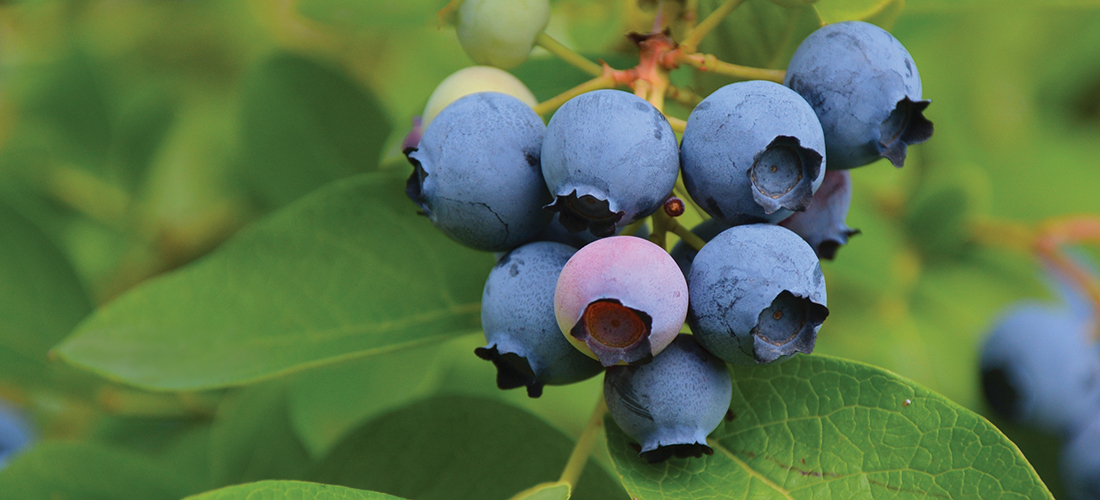
A feast of healthy fruit
By Jan Leitschuh
Remember the scene in the movie Forrest Gump, where Private Benjamin Buford “Bubba” Blue recites the endless uses of shrimp? For whimsy’s sake, let’s substitute blueberries . . . Well, of course there’s blueberry pie . . . blueberry jam . . . blueberry vinaigrette salad . . . blueberry breakfast cake . . . blueberry pavlova . . . blueberry pancakes . . . blueberry wine and cordials . . . blueberry ice cream . . . blueberry muffins . . . blueberry baked custard . . . blueberry smoothies . . . blueberry cobbler . . . blueberry mole chicken . . . blueberry buckle . . . blueberry lemonade . . . blueberry cheesecake . . . blueberries and oatmeal . . .
Hope you aren’t hungry.
One of the most beloved local fruits is coming into its abundance season this month — rabbiteye blueberries. You should be able to find them in area markets and Community Supported Agriculture boxes, or search them out on a family outing at Sandhills pick-your-owns. This sweet, popular and versatile fruit is loaded with heart-healthy antioxidants, so scarf down a bowl and the health halo remains undiminished.
If you’ve been watchful, you might have seen its earlier cousin, the Southern highbush blueberry, as early as June. The Southern highbush are not as common among home growers, being less carefree than the vigorous rabbiteye.
Rabbiteye blueberries are one of the easiest fruits for backyard gardeners to grow organically. Best of all, they can blend seamlessly into existing landscapes with a little forethought. To your neighbors, it’s just a nice hedge; to you, it’s an attractive, three-season fruit basket that fills the freezer with highly nutritious and delicious berries. It could be a three-bush “island” in the yard, perhaps near a sunny driveway or an accent fence. And from a landscaping point of view, what’s not to like? Tiny white pendant bells of flowers in the spring, lush hedging and blueberries in summer, and scarlet leaves in fall, with many remaining for winter. To start your blueberry patch all you need to know is how to prepare your site and which varieties work best around these sandy parts.
The rabbiteye blueberry is hardier and tougher than the Southern highbush that our area blueberry farms grow. Rabbiteyes are adaptable and less finicky, so, if it’s your first time, purchase them for the best chance of Sandhills success, and plant from October through March.
Though it’s too hot to plant now, preparing a suitable home right now is helpful. Site selection is the first step in growing your bushes. If you have full sun, that’s where they will be the happiest — and a happy blueberry bush is a productive blueberry bush. But if all you have is tall pines and dappled shade for part of the day, fear not. Rabbiteyes will produce a reasonable crop even when grown in part shade — as long as they receive at least four hours of full sunlight each day.
Plan for space. Rabbiteye blueberries can sprout into substantial bushes, usually 6-to-8 feet tall and wide. Left unpruned, they might even stretch up to 12-15 feet tall. I usually prune ours shorter after the last berries have been picked each summer, and my 14-year-old bushes mostly remain at waist to chest height.
Blueberries need acidic soil to grow well, preferring a soil pH of 4.0 to 5.5. This is lower than many plants will tolerate, even camellias and azaleas. Though our soil is already acidic, you may have to make it somewhat more so.
To learn your soil’s pH, take a sample to our local cooperative extension office for free testing. They have kits there, and instructions on how to gather the sample. Samples are sent to the North Carolina Department of Agriculture’s soil testing lab in Raleigh. The results are posted online, usually within three to six weeks. If you need to lower you pH, your local Extension horticulture agent can advise you how to carefully apply sulphur to your soil. They can also help you get the important soil phosphate levels correct.Blueberries prefer a soil with a high organic matter content. Start now by mixing in organic materials such as old leaf compost, pine bark, aged pine sawdust, rotted wood chips or mushroom compost. Organic matter will promote better root growth and better plant survival.
Buy at least two different named varieties, preferably three or four, for best crops. Rabbiteye blueberries need “friends” to pollinate — another variety must be growing close by to produce fruit. Plant two or more varieties within 100 feet of each other.
Choose a wider variety to ensure a longer season. Reliable varieties for our area include “Climax” and “Premier,” two early bearers, ripening in mid-to-late June. “Columbus” and “Onslow” are mid-season bearers, and the lovely, dusty “Powderblue” ripens late in the season, usually from July through early August.
Blueberry plants are very shallow rooted. Never plant them deeper than they were growing in the nursery or in the container. Mulch the plants after planting. This keeps soil moisture even, helping them grow and survive our hot summers. Use bark, aged wood chips and pine needles for attractive and helpful mulches. Your new plants are vulnerable, and for the first few seasons, water twice a week if the rains don’t come.
Mature blueberry bushes are very productive, and can produce 18-25 pounds of fruit per bush. Six to 10 bushes will provide a family of four all the berries they can eat for fresh use, with a surplus for freezing, jelly or jam — though you may want to plant a couple of extra bushes for the birds.
Speaking of birds, I don’t worry about them. We have plenty of bushes at our house, and always more berries than we can eat alone. The birdsong in the mornings as we pick, coffee cup in hand, balances the equation for us. But if your bushes are fewer, there are bird nets you can purchase and drape over the bushes. If you go this route, commit to checking your nets several times a day, as small birds can become entangled, overheat and die.
When harvesting rabbiteye blueberries, be aware that the berries turn blue well before they fully ripen. For sweeter fruit, wait 7 to 10 days after berries turn blue to pick. This gives the sugars time to accumulate.
From the state Extension website: “When setting out new plants it is recommended that you remove all of the flower buds during the first growing season. In year two, remove weak shoots and attempt to keep four main upright canes. Some flower buds may be kept to produce fruit in year two if the bush put on vigorous growth the previous year. Bushes may be allowed to produce a full crop starting the third growing season.”
But on to the good part — eating.
Besides fresh eating, you can toss blueberries into many ordinary things: your pancakes, waffles, oatmeal and muffins, your lettuce salads, over cakes, custards, desserts and cheesecake. Extra berries freeze easily, in a single layer on a cookie sheet, then packed away in bags.
Other than pie, probably the best known blueberry dessert is cobbler. So let the feasting begin:
Easy Blueberry Cobbler
1/2 cup butter
1 cup self-rising flour
1 cup sugar
1 cup milk
4 cups fresh blueberries
Preheat oven to 350 degrees. Place butter in an 8-inch square baking dish. Melt butter in the preheating oven, about 5 minutes. Remove from oven. Mix flour, sugar, and milk in a bowl until combined; pour batter over melted butter. Scatter blueberries over batter. Bake in preheated oven until a toothpick inserted into the center comes out clean, about 1 hour. PS
Jan Leitschuh is a local gardener, avid eater of fresh produce and co-founder of the Sandhills Farm to Table Cooperative.





